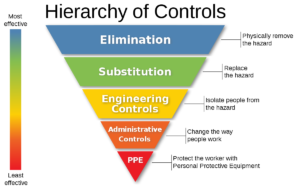
Assessing risks when emerging from lockdown
[vc_row][vc_column][vc_column_text]

[/vc_column_text][/vc_column][/vc_row]
Assessing risks as your charity prepares for the end of England's national lockdown
As the end of our second national lockdown comes to an end, it’s important to look at how your organisation assesses its risks.
The Health and Safety at work Act 1974 made it necessary for every organisation to think about how they protect their volunteers and staff. Risk assessments go far further than just those people, though, as beneficiaries and third parties should be considered as well.
Charity trustees are legally obliged to manage safety on behalf of their organisations.
Legal and financial costs for HSE prosecutions can have a huge impact on a charity’s resources. The average fine for failure to comply with the act is £200,000, with many public sector organisations facing fines of over £1,000,000. These figures do not include the compensation that could be awarded to the person or organisation affected.
There are also many costs that are not obvious. Examples of these are:
-
Downtime caused by an event
-
The employment of extra staff to replace somebody unable to work
-
The cost and time for investigations into an incident
-
Loss of business
-
Loss of reputation
-
Loss of funding
What steps can you put in place for your charity?
-
Identify a competent person to manage the charity’s risk assessments
-
Identify the hazards that your charity poses
-
Identify who might be harmed
-
Evaluate the risks & controls
-
Record, communicate and retain documents, decisions and incidents
-
Monitor risk assessments and check the controls in place
The HSE provides a guide to risk assessments here: https://www.hse.gov.uk/pubns/indg163.pdf
A useful tool is the Hierarchy Of Hazard Controls:

The key areas are eliminating hazards, replacing hazards, isolating people from hazards, changing the way people work and protecting the workers with personal protective equipment.
Every system of your charity’s work should be considered. Items to consider are:
Can work be carried out from home?
Is it safe for your workers to travel to places of work whilst following social distancing?
Can tasks be carried out safely whilst social distancing?
Can normal operations be carried out with fewer staff at work or when key people are absent?
What areas of your work should PPE be considered for?
With your charity altering the way it operates, will your staff need to work longer hours to complete the same tasks and, if so, how will fatigue affect both activities and staff well-being?
What to consider when writing your risk assessment?
-
Make sure your risk assessments identify all significant and foreseeable eventualities
-
Your risk assessments should not be over-complicated
-
Allow for flexibility
-
Leave the risk assessments open to interpretation
Covid-19 related considerations
-
Refer to Covid-19 Guidance
-
All mitigating measures must be taken to reduce the risk of transmission
-
Implement social distancing rules
-
Make home working part of the safe system of work
-
Make plans to minimise contact
What other areas might you need to reconsider following the current global pandemic?
-
Office safety/homeworking
-
Caretaking activities
-
Metal health and well-being of staff and volunteers
-
What roles your volunteers can assist with
-
First aid
-
Health risks
-
Changes to work place practices
-
Training for staff with new or changed job roles
Click HERE to find out more
Have any questions? please don’t hesitate to contact one of our team
Matt.price@ascendbrokingold.co.uk | Office: 01245 449062 | Mobile: 07841 020712
Recent Posts
Ascend Broking0 Comments
DDoS Attacks – What Do They Mean For Businesses?
Ascend Broking0 Comments
Good luck in Sunday’s London Marathon, Stuart!
Ascend Broking0 Comments





